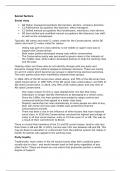Summary
Summary A-level Edexcel UK Politics 4 - Voting Behaviour and the Media
- Module
- Paper 1 UK Politics (9PL0)
- Institution
- PEARSON (PEARSON)
Comprehensive A* politics notes for Voting Behaviour and the Media. Includes statistics, examples and explanations for all key social factors (age, gender, education, region, race, class) and all voting theories, as well as examples and explanations for all types of media (newspapers, broadcasts, s...
[Show more]



